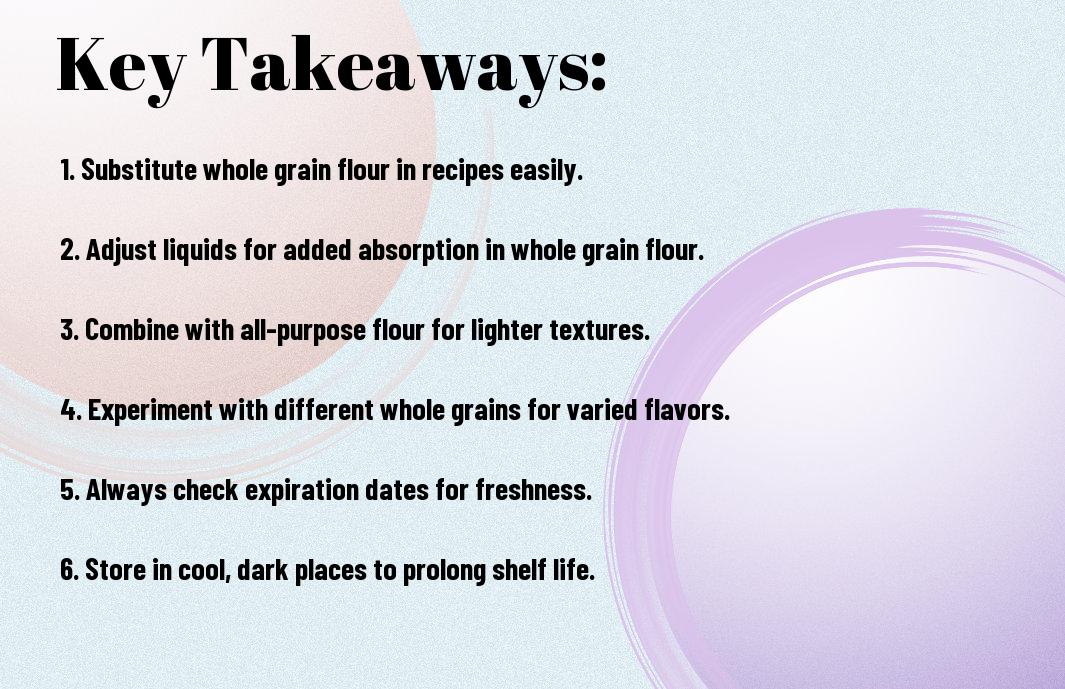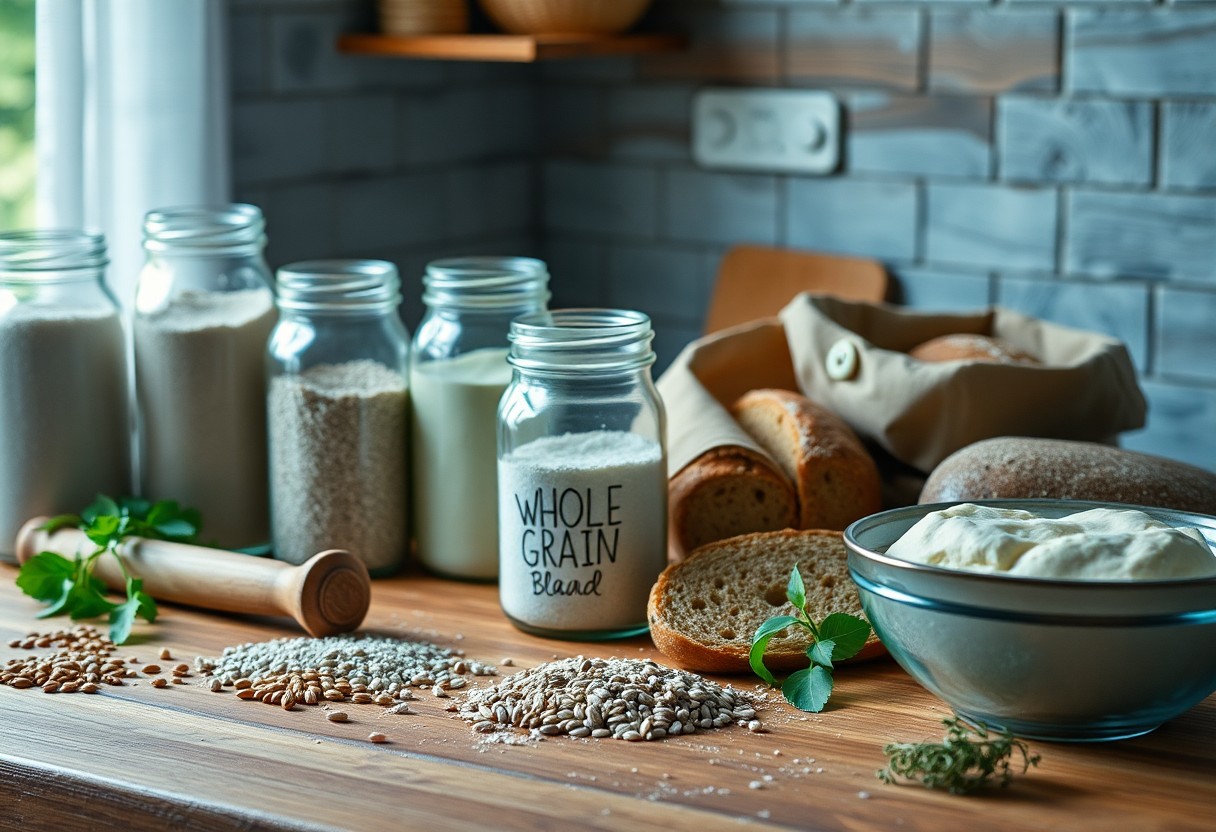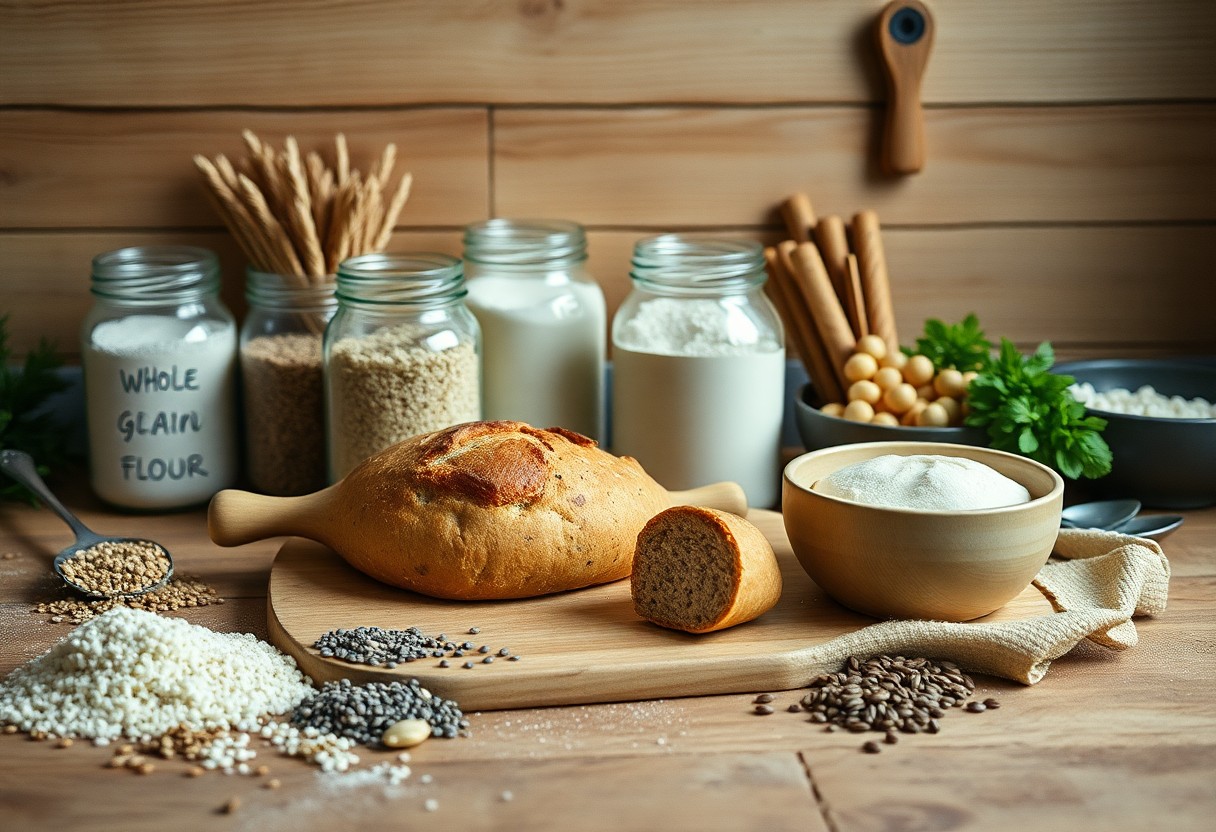Whole grain flour is a fantastic way to boost the nutritional value of your baked goods. By using this type of flour, you can enhance the fiber, vitamins, and minerals in your favorite recipes. However, adapting your baking techniques is imperative for achieving the right texture and flavor. In this post, you’ll learn how to effectively incorporate whole grain flour into your cooking to create healthier and more delicious dishes. Embrace the benefits of whole grain flour for a holistic approach to your baking adventures!
Key Takeaways:
- Whole grain flour can be used in a variety of baked goods, but it is recommended to start by substituting it for a portion of all-purpose flour to maintain texture and consistency.
- Incorporating additional liquids or wet ingredients may be necessary, as whole grain flours tend to absorb more moisture than refined flours.
- Experimenting with different types of whole grain flours, such as whole wheat, spelt, or rye, can add unique flavors and nutritional benefits to your recipes.


Understanding Whole Grain Flour
The whole grain flour is made from the entire kernel of the grain, including the bran, germ, and endosperm. This means that it retains all of the important nutrients and fiber, making it a more nutritious option compared to refined flours. By incorporating whole grain flour into your baking, you not only enhance the flavor but also add significant health benefits to your meals.
What is Whole Grain Flour?
Behind the definition, whole grain flour encompasses various grains such as wheat, rye, oats, and barley, ground together to offer a richer texture and taste. Unlike traditional white flour, which is stripped of many nutrients during processing, whole grain flour maintains the integrity of the grain, providing you an abundant source of vitamins and minerals in each cup.
Nutritional Benefits
Beside its rich flavor, whole grain flour is packed with benefits that greatly enhance your diet. By switching to whole grain flour, you increase fiber intake, which aids in digestion and can help maintain a healthy weight. Additionally, whole grains are known for their lower glycemic index, offering more stable energy levels and reducing spikes in blood sugar.
But the benefits of whole grain flour go beyond basic nutrition. Whole grains are linked to a reduced risk of heart disease, diabetes, and certain cancers due to their high levels of antioxidants and important fatty acids. Furthermore, the added fiber promotes a sense of fullness, which can curtail overeating and lead to healthier eating habits. By incorporating whole grain flour into your recipes, you empower your health while indulging in delicious baked goods.
Substituting Whole Grain Flour in Recipes
Some recipes can easily accommodate whole grain flour, allowing you to enjoy its nutritional benefits without sacrificing taste. Begin by substituting up to 50% of the all-purpose flour with whole grain flour in your favorite baked goods, such as breads, muffins, and pancakes. As you become more comfortable, you can gradually increase the amount, keeping an eye on texture and flavor. Whole grain flour adds a hearty touch and enhances the nutritional profile of your dishes.
Measuring Accuracy
Below is a key aspect of successful baking with whole grain flour. For best results, use the scoop-and-level method when measuring your flour, ensuring you don’t pack it down. A kitchen scale is ideal for achieving consistent results and precision. This approach helps you maintain the right balance of dry ingredients and ensures your baked goods turn out perfectly.
Adjusting Liquid Ratios
About 30% more liquid may be needed when incorporating whole grain flour into your recipes. Whole grains retain moisture differently than all-purpose flour, which may lead to denser textures if not accounted for. Adjust your liquid ingredients carefully to achieve the desired consistency. Failing to adjust could result in dry or crumbly baked goods.
Considering the moisture properties of whole grain flour, you may need to experiment with your liquid ratios to achieve the desired texture. Whole grain flour has a higher fiber content, which means it absorbs more liquid. For best results, start by increasing your liquid by about 10% and then assess the mixture. If it seems dry, you can gradually add more until you reach the optimal consistency. This ensures your baked goods remain moist and flavorful, providing a healthier alternative without compromising taste.

Tips for Baking with Whole Grain Flour
To achieve the best results with whole grain flour, keep these tips in mind:
- Start by substituting half of your regular flour with whole grain flour to gauge flavor and texture.
- Increase your liquid content slightly, as whole grain flour can absorb more moisture.
- Allow your dough or batter to rest for a short period to let the flour fully hydrate.
- Mix the ingredients gently to avoid overworking the gluten.
The transition to whole grain baking may take some time, but it is well worth it for your health.
Flavor Pairings
Before you start baking, consider pairing whole grain flour with complementary ingredients to enhance the flavor. Ingredients like honey, cinnamon, or nuts can bring out the earthiness of the flour, while adding fruits like bananas or berries can provide a natural sweetness. Feel free to experiment with spices and extracts like vanilla to elevate your baked goods.
Texture Considerations
Around the time you begin baking, you should be mindful of the texture whole grain flour brings to your recipes. Whole grain flour has a coarser texture compared to refined flour, which can impact the overall structure of your baked goods.
The incorporation of whole grain flour may lead to denser and heartier baked items, which can be a delightful change. To achieve a lighter texture, you can blend whole grain flour with high-protein flours, or simply allow your batter to rest, enabling gluten development. You will find that adjusting baking times and methods is also helpful for achieving the desired results. Embracing this adjustment can enhance the quality and nutritional value of your baking.
Whole Grain Flour in Different Types of Baked Goods
Many bakers are discovering the benefits of using whole grain flour in various baked goods, enhancing both nutrition and flavor. Here are some ways you can incorporate it:
- Bread
- Pastries
- Cookies
- Cakes
- Muffins
Knowing how to effectively use whole grain flour in your baking will elevate your creations and contribute to a healthier lifestyle.
| Type of Baked Good | Best Practices |
|---|---|
| Bread | Incorporate half whole grain flour for texture. |
| Pastries | Blend with all-purpose flour for flakiness. |
| Cookies | Replace up to 1/4 of all-purpose flour. |
| Cakes | Combine with cake flour to maintain lightness. |
| Muffins | Use whole grain for moisture and flavor. |
Bread
Grain enthusiasts enjoy baking with whole grain flour as it adds depth and a nutty flavor to your breads. Start with a mix of all-purpose and whole grain flours to acclimate your baking skills. This blend helps maintain a light texture while delivering the health benefits of whole grains. Over time, you can increase the proportion of whole grain flour in your recipes.
Pastries and Cookies
To create inviting pastries and cookies, it’s vital to adjust your recipes when using whole grain flour. You can maintain the delicate texture by mixing it with all-purpose flour, ensuring your baked goods are still light and tender.
Baked goods like cookies can also become healthier with whole grain flour, but it’s imperative to pay attention to the balance of ingredients. You can mix whole wheat with all-purpose flour to enhance the flavor while keeping the texture delicious and soft. This approach will allow you to indulge with a lighter conscience, knowing you’re choosing a nutritious option!
Storing Whole Grain Flour
Once again, proper storage of whole grain flour is necessary to maintain its quality and freshness. Whole grain flour contains natural oils from the grain’s germ, making it susceptible to rancidity. To keep your flour in the best condition, store it in an airtight container in a cool, dark place. This will shield it from light and moisture, preserving its flavor and nutritional benefits.
Optimal Storage Conditions
About storing your whole grain flour properly, you’ll want to make sure it is kept at a consistent temperature, ideally below 70°F (21°C). A dedicated pantry or refrigerator can provide the ideal environment, reducing the risk of spoilage and maintaining its rich nutrients. Ensure your containers are tightly sealed to avoid moisture and pests.
Shelf Life and Freshness
With whole grain flour, freshness is key to achieving the best flavor and nutritional value in your baked goods. Ideally, it should be consumed within 3 to 6 months for optimal taste and performance, but if stored in the freezer, it can last up to a year or more.
Grain flour’s shelf life and freshness depend significantly on its storage conditions. Whole grain flour, while nutritious and packed with flavor, can spoil quickly if exposed to air, heat, or moisture. Always check for rancid odors or discoloration, which indicate that it may no longer be good to use. By following proper storage techniques, you can ensure that you have fresh, wholesome flour ready for all your baking needs.
Creative Uses for Whole Grain Flour
Unlike all-purpose flour, whole grain flour can transform various dishes beyond traditional baking. You can experiment by adding it to pancakes, waffles, and even homemade pasta. Whole grain flour’s earthy flavor enhances the taste of your favorite baked goods and makes them more nutritious. Don’t hesitate to substitute a portion of regular flour in your recipes; this small change can lead to significantly healthier meals.
Beyond Baking
Against common belief, whole grain flour isn’t limited to muffins and bread. You can also use it to create savory dishes that benefit from its rich taste and added nutrition. Think about coatings for meats, mixes for fritters, or even adding it to soups and sauces to thicken them while boosting their fiber content, ensuring a more filling meal.
Incorporating into Meals
Against typical habits, you can integrate whole grain flour into your meals in surprising ways. Start adding it to your smoothies, sprinkling it into your favorite sauces, or even using it as a thickener for stews. It not only increases the nutritional value of your meals but also provides a satisfying texture that enhances your cooking.
Another excellent way to incorporate whole grain flour into your meals is by using it as a base for homemade breading. Combine it with spices and herbs to make a flavorful coating for baked or fried foods. Its nutty taste complements proteins like chicken, fish, or tofu wonderfully, giving your meals a nutritious boost. Furthermore, by using whole grain flour, you can make pasta, pizza dough, or even energy bars, ensuring that your meals remain healthy and delicious.
Conclusion
The use of whole grain flour can transform your baking, enhancing the nutritional value of your favorite recipes. By gradually incorporating it into your baking routine, adjusting liquid ratios, and experimenting with different types, you can create delicious, healthier treats. Whether you’re making bread, muffins, or cookies, these tips will empower you to enjoy the benefits of whole grains while keeping your meals flavorful and satisfying. Embrace these techniques to elevate your kitchen experience and make mindful choices for your health.
FAQ
Q: What is whole grain flour, and how does it differ from all-purpose flour?
A: Whole grain flour is made by grinding the entire grain kernel, which includes the bran, germ, and endosperm, whereas all-purpose flour primarily contains only the endosperm. This means whole grain flour retains more nutrients and fiber, making it a healthier option for baking. Whole grain flours, such as whole wheat, spelt, or rye, have a denser texture and can provide a richer flavor to baked goods.
Q: How can I substitute whole grain flour for all-purpose flour in recipes?
A: When substituting whole grain flour for all-purpose flour, it is recommended to start with a 50/50 ratio. Use half whole grain flour and half all-purpose flour to see how the texture and flavor of your baked goods are affected. You may need to adjust the liquid content of the recipe slightly since whole grain flour absorbs more liquid. Gradually increase the proportion of whole grain flour as you become more comfortable with the baking properties.
Q: What adjustments do I need to make when baking with whole grain flour?
A: Baking with whole grain flour often requires a few adjustments. First, consider adding extra liquid to prevent baked goods from being too dry. Additionally, increasing the resting time of your dough can help improve texture and rise, as it allows the flour to fully hydrate. You may also need to reduce the baking temperature slightly to avoid over-browning.
Q: Are there specific types of whole grain flour I can use for different baked goods?
A: Yes, various types of whole grain flour can enhance different baked goods. Whole wheat flour is versatile and works well for bread, muffins, and pancakes. Spelt flour has a slightly sweet and nutty flavor, making it great for cookies and cakes. Rye flour can add depth to bread and baked goods. Experimenting with different types can enhance flavors and textures in your cooking.
Q: How do I store whole grain flour to ensure its freshness?
A: Whole grain flour should be stored in a cool, dry place, ideally in an airtight container to prevent moisture absorption and pest infestation. For longer shelf life, consider refrigerating or freezing the flour as it contains oils that can go rancid. Make sure to bring the flour back to room temperature before using it in recipes. Proper storage will help maintain its nutritional quality and flavor over time.
